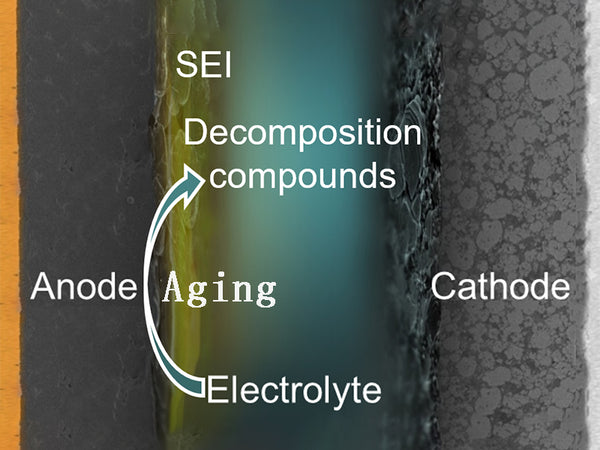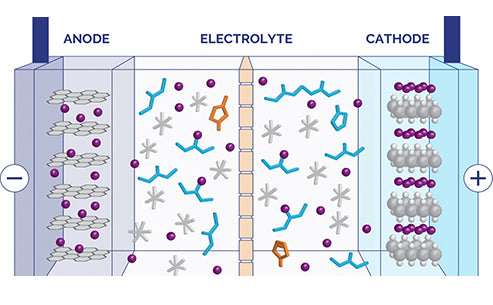
main content:
Like any other secondary battery, the capacity of a lithium-ion battery decreases as the number of cycles increases. The reasons for the loss or reduction of battery capacity are the irreversible structural phase change of the electrode material itself during the charging and discharging process, and the structure of the electrode material becomes partially or completely irreversible due to the disturbance or even destruction of the structure of the electrode material due to repeated lithium insertion/delithiation. In addition, another very important reason is the chemical or electrochemical side reaction between the electrolyte and the electrode material, which leads to the decomposition of the electrolyte, and other problems that occur with the decomposition of the electrolyte, such as the loss of the solvent or the lithium salt, which leads to the decrease of the electrolyte conductivity. , The deposition of decomposition products on the electrode blocks the micropores on the electrode material particles and slows the rate of ions in and out of the electrode.
1. Electrolyte aging decomposition

Someone has studied the mechanism of the aging and degradation of the liquid electrolyte in lithium-ion batteries during long-term storage and cycling, and pointed out that the aging of lithium-ion batteries mainly comes from the reaction between the active material and the electrolyte at the electrode interface, and the material structure during the cycle. The degradation of the battery and the aging of inactive components (such as binders) lead to the degradation of battery energy density and/or power density. The reaction rate of the electrolyte depends on factors such as the types and reactivity of electrode materials and electrolyte materials, the types and contents of impurities contained in each part of the battery system, the preparation process, the battery design, the type of application, and the way of use.
2. Normal reduction and decomposition of electrolyte

+
+xe+6CLixC6 (0≤x≤1), but the actual reaction process is much more complicated. Some side reactions involving electrolytes are important reasons for the capacity loss (or charge loss) during the lithium insertion/delithiation process. The charge loss is accompanied by the consumption of materials (lithium ions and electrolyte). The side reactions involving electrolytes that occur on graphite anode materials should include at least the following aspects.(1) Electrolyte reductively decomposes on the surface of the negative electrode

Electrolyte molecules that are in direct contact with the negative electrode material during the discharge process will get electrons (because the electrode material is generally a mixed conductor of electrons and ions) and be reduced. For EC and DMC carbonate molecules, the result of the reduction reaction is to generate Li2CO3 and deposit on the surface of the negative electrode. This reduction process has nothing to do with the type of negative electrode material used.
As the discharge process progresses, graphite intercalation compound LixC6 will be generated on the carbon electrode. Like metal lithium, LixC6 is thermodynamically unstable in almost all liquid electrolytes, so the reduction and decomposition of the electrolyte will continue. Only when the surface of all carbon particles are covered by the decomposition products of the electrolyte, and the surface of LixC6 is no longer directly exposed to the electrolyte, the electrolyte reaction may stop. In the subsequent cycles, the battery will show very good reversibility, and there will be no significant loss of capacity after multiple cycles. For non-carbon anode materials, although LixC6 compounds will not be generated, these anode materials must form LixM alloys with properties very similar to metallic lithium before they can effectively store lithium, so similar electrolyte decomposition and capacity loss still exist. In addition, metal oxide electrode materials generally need to be reduced to metal atoms before forming LixM alloys with lithium. The reduction process also consumes a large amount of electric charge, resulting in a high irreversible capacity loss. Therefore, the reductive decomposition of the electrolyte is inevitable. The film that coats the surface of the negative electrode material particles and can prevent further decomposition of the electrolyte is called a passivation film. The reduction and decomposition of the electrolyte requires a large amount of material to be consumed, which reduces the capacity of the battery, and even increases the internal pressure of the battery due to the production of some gas, which brings problems to the safety of the battery.
The decomposition products of the electrolyte include lithium carbonate, lithium alkyl ester, oligomers, etc., as well as various gases such as CO2 and some liquid molecules. The film covering the negative electrode material particles is insulative to electrons and conductive to ions. Therefore, it is generally called a solid electrolyte interface (SEI) membrane. The SEI film is generally formed during the first lithium insertion process of the battery and is further consolidated and improved in the subsequent cycling process. The composition of the electrolyte (including salt and solvent) and the surface properties of the electrode material determine the decomposition products of the electrolyte, and also determine the potential at which the electrolyte will undergo reductive decomposition and whether a stable and effective SEI film (including the SEI film) can be formed on the surface of the negative electrode material. Composition, morphology, conductivity, stability). For graphite electrodes, the reduction and decomposition of the electrolyte can occur on the basal surface of graphite (the surface parallel to the graphite layer) or the edge surface of the graphite (the surface perpendicular to the graphite layer). The proportions of these two surfaces in different types of BET surface graphite (even from the same source but processed by different methods) are different.
(2) Solvent co-embedding

Ideally, the solvent molecules should be removed before the solvated lithium ions are intercalated between the graphite carbon layers so that the lithium ions can enter the graphite interlayers. In fact, when lithium-graphite intercalation compounds are formed in an aprotic solvent , Some polar solvents such as PC and dimethoxyethane will be inserted between the graphite layers together with lithium to form a ternary graphite intercalation compound, such as Lix(solvent) C6. This phenomenon is called solvation intercalation or solvent co-intercalation.
Solvated intercalation compounds are thermodynamically and kinetically unstable, so polar solvent molecules co-intercalated with lithium ions are prone to reductive decomposition. Since lithium ions can only be embedded in the graphite layer along the direction parallel to the basal surface, specific reactions related to discharge loss, such as the insertion of solvated lithium ions or the self-discharge of lithium ions that have been embedded in graphite, only pass through or only on the edge surface. Happened (Novak calls this prismatic). It is generally believed that the use of PC-based electrolytes is prone to solvent co-intercalation, while the use of EC-based electrolytes can effectively avoid solvent co-intercalation. Therefore, commercial lithium-ion batteries generally use EC-based electrolytes, but the use of EC-based electrolytes cannot completely avoid the delamination and powdering of the graphite negative electrode.
For non-graphitized carbon materials (such as various hard carbon materials), although the decomposition of the electrolyte caused by the solvent co-intercalation reaction is secondary, due to the large specific surface area of such carbon materials, there are a large number of functional groups on the surface and other factors Therefore, the irreversible capacity loss of the first discharge of this type of electrode material is also very large. The coulombic efficiency of graphite anode materials such as natural graphite and mesophase carbon microbeads (MCMB), which are widely used in lithium-ion batteries, can reach 80% or even more than 90% in the first cycle, while the coulombic efficiency of hard carbon anode materials is only Around 50%.















